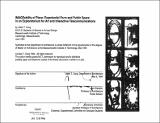| dc.contributor.advisor | Jan Wamploer. | en_US |
| dc.contributor.author | Sung, Lillian T. (Lillian Thailian) | en_US |
| dc.contributor.other | Massachusetts Institute of Technology. Dept. of Architecture. | en_US |
| dc.date.accessioned | 2012-04-26T18:26:02Z | |
| dc.date.available | 2012-04-26T18:26:02Z | |
| dc.date.copyright | 1994 | en_US |
| dc.date.issued | 1994 | en_US |
| dc.identifier.uri | http://hdl.handle.net/1721.1/70239 | |
| dc.description | Thesis (M. Arch.)--Massachusetts Institute of Technology, Dept. of Architecture, 1994. | en_US |
| dc.description | Includes bibliographical references (p. 104-105). | en_US |
| dc.description.abstract | In the advent of the intelligent age, the focal point of communal activity becomes the civic forum of information exchange. The interface of art, information and communication to the civic arena anticipates a public place for collective creativity and intelligence. An Exploratorium for Art and Interactive Telecommunications can become the heart of a city's activities with different levels of individual and group participation in the public exchange of ideas, thoughts, issues and events. Such a place of discourse can become a center to create, contemplate and learn, a place that is an extension of ourselves, our city and beyond. Interactive telecommunications speaks a language of creativity and connection. It is a technology not of monologue but of conversation. This local forum can become an urban oasis for the freedom of interaction and personal expression in an unfolding chain of dramas that will impart new meaning to the city symbolic. Amidst the shifting complexity of an urban environment, such a public place of high imageability can form a stable focus for daily human existence. The imageability of the Exploratorium need not arise purely from monumentalism or novel aesthetics. The legibility of this public place can instead ensue from a rich application and ordering of experiential form. The design intention of this thesis is to create a public place with a spirit and identity that is vivid, distinct and engaging to the individual; an imageable place of public pride and civic rejuvenation that reflects both the depth and the complexity of a collective human experience. | en_US |
| dc.description.statementofresponsibility | by Lillian T. Sung. | en_US |
| dc.format.extent | 105 p. | en_US |
| dc.language.iso | eng | en_US |
| dc.publisher | Massachusetts Institute of Technology | en_US |
| dc.rights | M.I.T. theses are protected by
copyright. They may be viewed from this source for any purpose, but
reproduction or distribution in any format is prohibited without written
permission. See provided URL for inquiries about permission. | en_US |
| dc.rights.uri | http://dspace.mit.edu/handle/1721.1/7582 | en_US |
| dc.subject | Architecture. | en_US |
| dc.title | IMAGEability of place : experimental form and public space in an exploratorium for art and interactive telecommunications | en_US |
| dc.title.alternative | Experimental form and public space in an exploratorium for art and interactive telecommunications | en_US |
| dc.type | Thesis | en_US |
| dc.description.degree | M.Arch. | en_US |
| dc.contributor.department | Massachusetts Institute of Technology. Department of Architecture | |
| dc.identifier.oclc | 31262097 | en_US |
